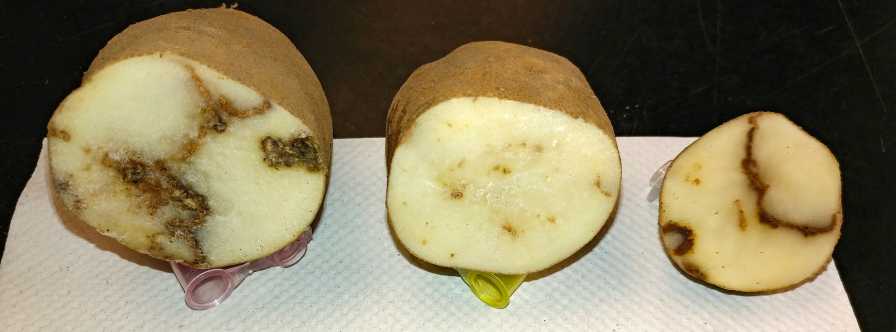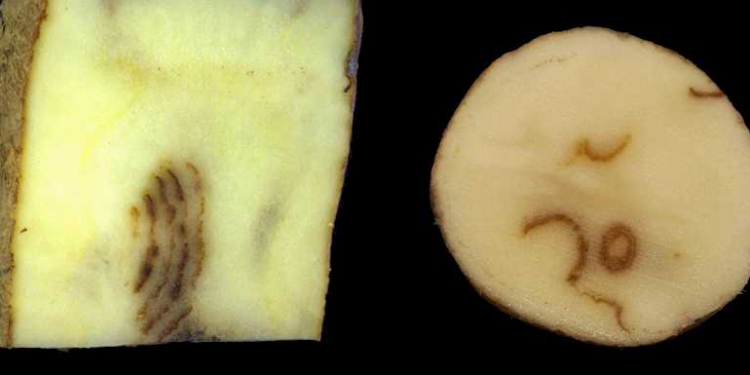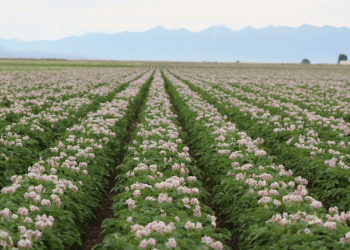A diagnostic lab had to confirm these potato mop-top virus (PMTV) symptoms. Note concentric arcs that can occur with these viruses. This textbook symptom of spraing can be misleading because it does not always occur.
Photo by Jordan Eggers
Potato mop-top virus (PMTV) and tobacco rattle virus (TRV) are very different viruses, but the symptoms they cause are virtually identical.
“Spraing” is an old term used to describe the brown arcs, flecks, or rings in the flesh of tubers that result from potato mop-top or tobacco rattle infection. If you see these symptoms, it’s important to find out which virus you are dealing with, because their management strategies differ. Symptomatic tubers should be sent to a diagnostic lab that will use a DNA-based test to distinguish the viruses.
PMTV Causes Mop-Top Disease
The soil-borne pathogen that causes powdery scab disease, Spongospora subterranea (a protozoan), spreads PMTV to potatoes. It can survive in soils as resting spores for many years and, once introduced, is almost impossible to get rid of. The spores hold PMTV, where it remains viable for a long time. Infection occurs mostly during tuber initiation and the early bulking phase and is promoted by high soil moisture and cool temperatures.

Photo by Launa L. Cimrhakl
Stubby root nematodes transmit TRV to potatoes (Trichodorus and Paratrichodorus species). The nematodes acquire the virus while feeding on the roots of infected plants. Stubby root nematodes and TRV have wide host ranges, and many crops and weeds serve as reservoirs of the virus. The virus can also be spread on knives or other tools used to cut seed tubers for planting.
Common Features and Controls
- They rarely cause foliar symptoms.
- Tuber symptoms can be confused with those of physiological disorders, like internal brown spot and heat necrosis.
- Symptoms do not usually occur uniformly within a field. Infected tubers do not always show symptoms. Symptoms may not be noticeable at harvest, and symptom intensity can increase in storage.
- Some cultivars are more likely to produce spraing symptoms with TRV and/or PMTV than others.
- Both viruses are introduced into new fields through movement of vector-infested soil, manure, or plant debris (like cull potatoes) and/or by planting infested seed tubers.
- Prevention is the first and best strategy for managing these viruses. Avoid introducing PMTV and TRV and their vectors into your fields. Inspect potato seed for lesions before you plant. Do not move infested soil, manure, or plant debris into clean fields. Clean and sanitize all machinery when moving from infested fields to non-infested fields.
- If you are going to plant infested fields, it is important to follow a strict sanitation protocol.
- In already infested fields, grow cultivars that are less likely to express spraing symptoms. You can find rankings of many cultivars by their sensitivity to TRV or PMTV-induced tuber symptoms in Extension bulletins.
Additional Management for PMTV
- A limited number of labs assay the soil for the presence of PMTV and/or powdery mildew spores.
- There are no good powdery scab controls. Soil fumigation with metam sodium (e.g., Vapam) may reduce inoculum levels in the soil but will not completely eliminate powdery scab spores or PMTV. Studies show an in-furrow application of fluazinam (Omega, Syngenta) at planting suppresses low to moderate powdery scab.
Additional Management for TRV
- Destroy weed hosts of TRV and rotate with non-host crops to reduce TRV inoculum.
- Routinely test soils for stubby root nematodes so you can make informed management decisions. Ideally, collect soil samples to a 6- to 10-inch depth when soil temperatures are around 70°F and the soil is moist. Stubby root nematodes are highly mobile and will move down 2 to 3 feet to avoid temperature extremes.
- Stubby root nematodes (and TRV) can be suppressed with fumigants (Telone) or other nematicides, e.g., Vydate (Corteva), Velum Prime (Bayer CropScience), Movento (Bayer CropScience).
Controlling stubby root nematodes with fumigants can be difficult because of their mobility, however. Yet fumigate in late summer or fall, because spring soil temperatures are usually too cold and dry for effective treatment.








